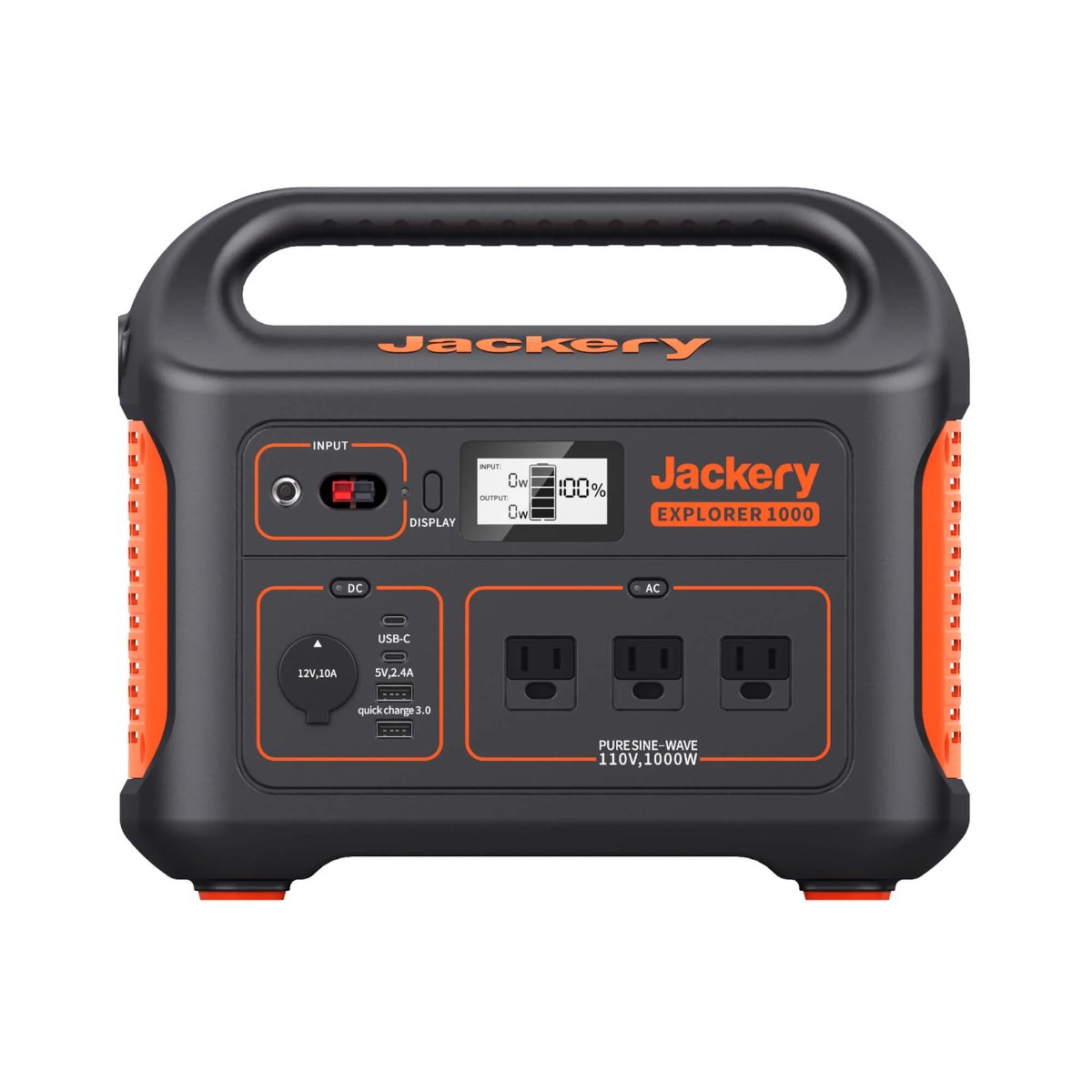Welcome to our complete and in-depth Jacker Explorer Portable Power Station review. Here we take a tried and tested look at one of the most popular solar power stations available to buy. It is our hope this will help you decide whether or not this portable power station is right for you and your personal needs.
Check out the best price for the Jackery Explorer 1000 by clicking here.
Jackery Explorer 1000 Portable Power Station Review

Jackery Explorer 1000 – Product Description
Storage Capacity and Power
The Explorer 1000 is equipped with a comprehensive battery management system and boasts 1002 Watt-hours of lithium-ion battery cells. This impressive capacity enables it to sustain a 1000W device, such as a travel kettle (refer to our video below), for one hour. Alternatively, it can power a 50W laptop continuously for an impressive 20 hours – a remarkable feat.
In terms of power delivery, the Explorer 1000 excels in powering up to 1000W appliances continuously. Additionally, it can gracefully handle a momentary surge of power at start-up, reaching up to 2000W. This surge power limit proves invaluable as numerous devices draw more power immediately at start-up before settling into continuous operation.
What can it power?
The Jackery Explorer 1000 is a versatile power station capable of powering a wide range of devices and appliances. With a robust 1002 Watt-hour lithium-ion battery capacity and powerful inverter, the Explorer 1000 can efficiently power:
- Laptops and Electronics: Charge laptops, smartphones, tablets, cameras, and other electronic devices.
- Kitchen Appliances: Run small kitchen appliances like blenders, coffee makers, and even a travel kettle.
- Refrigerators: Power small to medium-sized refrigerators or coolers.
- Power Tools: Operate various power tools for DIY projects or emergencies.
- Medical Devices: Keep essential medical devices, such as CPAP machines, running during power outages.
- Lights and Fans: Illuminate spaces and run small fans for comfort during outdoor activities or power outages.
- Entertainment Devices: Use it to power TVs, gaming consoles, or speakers for entertainment.
- Outdoor Equipment: Charge electric grills, portable stoves, or other outdoor equipment during camping or outdoor events.
- Electric Blankets: Keep warm with powered electric blankets during cold weather.
- RV Appliances: Power essential appliances in your RV, like lights, fans, or small kitchen devices.
The Jackery Explorer 1000’s versatility makes it a reliable choice for a wide range of applications, from outdoor adventures to emergency backup power at home.
During this Jackery Explorer 1000 review I tried many devices that were rated as 1000 watts and had no issues with the power station at all. It is good to know that this unit has a 2000 watt surge protection system which protects your devices and the Jackery.
Check out the best price for the Jackery Explorer 1000 by clicking here.

Jackery Explorer 1000 – Inputs
The Explorer 1000 features two input ports: a standard 8mm female connector and a pair of Anderson Power Pole connectors.
The 8mm input is compatible with the 240V AC power supply and 12V DC cigarette lighter power cables provided in the package. Charging from 0% to 100% takes approximately 6 hours and 45 minutes using AC power and slightly longer, around 7 hours, with the car charger. Additionally, you have the option to connect a single Jackery SolarSaga panel to this input, delivering approximately 65W under full sunlight. The charging time in this scenario is around 16-17 hours, which may extend further under overcast conditions.
Fortunately, you can link two SolarSaga panels together in parallel and connect them to the alternative Anderson Power Pole input on the Explorer 1000. This involves using the dual Y-cable included in the package, transforming the Jackery into an entirely solar-powered device. With two panels, the charging time decreases to approximately 8 hours under full sunlight, a manageable timeframe, especially during the UK summer for fortunate individuals. It’s important to note that adjusting the panels to face the sun periodically maximizes the generated power.
It’s essential to mention that you cannot utilize both the 8mm input and the Anderson input simultaneously for charging; it’s a choice between one or the other.
Output Connectors – Powering Your Gadgets
Jackery Explorer 1000 in Use
Jackery Explorer 1000 – Charge Times and Solar Charging
The Explorer 1000 faces a notable drawback in the UK when it comes to charging time. When using AC power, the Jackery takes approximately 6.5-7 hours to reach a full charge, a significant portion of the day and notably slower than comparable products from major competitors like Bluetti, EcoFlow, and Anker. Jackery has introduced a new ‘Pro range’ with considerably faster charge times.
While charge time may not be a critical factor in some cases – as the Jackery products can still be used while charging – there are limitations. The maximum power input is around 130W, restricting the use of larger appliances if you want to both increase the stored charge and use devices simultaneously.
The challenge intensifies with solar power, particularly in the UK. The SolarSaga 100 panels provide approximately 65W each to the Jackery, totaling around 130W when used in parallel. However, this is only achievable under direct, bright sunlight conditions, which are infrequent in the UK. Even on sunny days, the changing angle of the sun as the Earth revolves necessitates regular adjustments to the panel angles.
During a sunny day in the UK, I positioned the Jackery Explorer 1000 with two Solar Saga panels under bright sunlight to charge from a 25% initial level. Without adjusting the panel angles, I left the system for 5 hours. By the end, the Jackery reached approximately 50%, adding about 250Wh of capacity, translating to an increase of around 50Wh per hour of charging. While the result wasn’t disappointing, relying on the sun to go from 0% to 100% in a full day under cloudy conditions seems challenging, especially with some power draw, such as a cool box.
There seems to be a balance point where a modest amount of power draw (e.g., a laptop and a cool box) can be balanced against the input power generated from two solar panels on a cloudy day in the UK. While it may pose some challenges, the liberation of having access to free power outweighs concerns about insufficient sunlight due to an overcast sky – a factor of living in the UK rather than Arizona!
For a more reliable solution, having solar panels on the roof of a campervan or caravan appears to be the way forward. This allows the Jackery to charge while driving and not using much power. Upon reaching the destination, setting up the Solar Saga panels can continue the charging process. While it may involve some upfront costs, it likely presents the most effective solution to consistently keep the Explorer 1000 fully charged.
Check out the best price for the Jackery Explorer 1000 by clicking here.

Jackery Explorer 1000 Review Conclusion
In conclusion, my experience through this Jackery Explorer 1000 review left me thoroughly impressed with its role as a progressive step towards harnessing green and sustainable energy for camping in the UK. Despite the weather variability that poses a challenge for solar power in the UK, limiting the Explorer 1000’s ability to rely solely on solar charging, the awe-inspiring sensation of tapping into free energy makes it a highly recommended rechargeable power pack.
Especially well-suited for powering significant AC appliances like toasters and travel kettles, the Explorer 1000 proves efficient for various camping essentials, promising a transformative impact on your camping lifestyle. For optimal performance, I strongly recommend complementing it with two Solar Saga 100 panels. This setup enhances your recharging capabilities through solar power, particularly beneficial during wild camping scenarios without access to mains hookup or traditional generators.
Check out the best price for the Jackery Explorer 1000 by clicking here.
Take a look at more tech stuff here.


